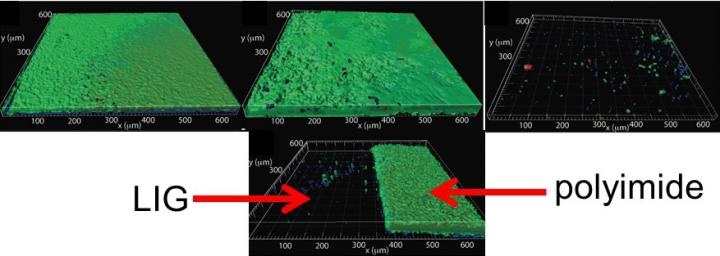May 23 2017
 In the top row, the growth of biofilm on surfaces with a solution containing Pseudomonas aeruginosa is observed on, from left, polyimide, graphite and laser-induced graphene surfaces. Green, red and blue represent live bacteria, dead bacteria and extracellular polymeric substances, respectively. At bottom, a sheet of polyimide burned on the left to leave laser-induced graphene shows the graphene surface nearly free of growth. Courtesy of the Arnusch Lab/BGU
In the top row, the growth of biofilm on surfaces with a solution containing Pseudomonas aeruginosa is observed on, from left, polyimide, graphite and laser-induced graphene surfaces. Green, red and blue represent live bacteria, dead bacteria and extracellular polymeric substances, respectively. At bottom, a sheet of polyimide burned on the left to leave laser-induced graphene shows the graphene surface nearly free of growth. Courtesy of the Arnusch Lab/BGU
Recently, scientists from Rice University and Ben-Gurion University of the Negev (BGU) explored the fact that induced graphene (LIG) is an extremely effective anti-fouling material and becomes a bacteria zapper when electrified.
LIG is considered to be a spongy version of graphene, the single-atom layer of carbon atoms. It was developed three years ago by the Rice lab of chemist James Tour. This was done by burning partway via a costly polyimide sheet with a laser, which transformed the surface into a lattice of interconnected graphene sheets. Since then the researchers have suggested applications for the material in fuel cells, wearable electronics and also for superhydrophilic or superhydrophobic surfaces.
The report published in the American Chemical Society’s ACS Applied Materials and Interfaces highlights that LIG also protects surfaces from biofouling, which refers to the buildup of plants, microorganisms or other biological material on wet surfaces.
This form of graphene is extremely resistant to biofilm formation, which has promise for places like water-treatment plants, oil-drilling operations, hospitals and ocean applications like underwater pipes that are sensitive to fouling. The antibacterial qualities when electricity is applied is a great additional benefit.
James Tour, Chemist, Rice University
LIG, when employed as electrodes with a small applied voltage, turns into the bacterial equivalent of a backyard bug zapper. Tests without the charge established what has long been known — that graphene-based nanoparticles comprise of antibacterial properties. The highly conductive LIG electrodes majorly improved those properties when 1.1 to 2.5 volts were applied.
Under the microscope, the team observed how fluorescently tagged Pseudomonas aeruginosa bacteria in a solution with LIG electrodes above 1.1 volts were pulled toward the anode. The cells started to disappear and later vanished completely within 30 seconds when above 1.5 volts. At 2.5 volts, the bacteria almost completely disappeared from the surface after one second.
The Rice lab collaborated with Professor Christopher Arnusch, a lecturer at the BGU Zuckerberg Institute for Water Research who concentrates on water purification. LIG electrodes in a bacteria-laden solution with 10% secondary treated wastewater were tested by Arnusch’s lab. The lab discovered that after nine hours at 2.5 volts, 99.9% of the bacteria were killed and the electrodes firmly resisted biofilm formation.
The researchers suspect that a combination of contact with the electrical charge, rough surface of LIG and the toxicity from localized production of hydrogen peroxide could lead to the termination of bacteria. The contact could resemble something like a knee hitting pavement, but here, the bacteria are all knee and the graphene edges, which are sharp, rapidly destroy their membranes.
Tour stated that LIG’s anti-fouling properties fortunately keep dead bacteria from accumulating on the surface.
The combination of passive biofouling inhibition and active voltage-induced microbial removal will likely make this a highly sought-after material for inhibiting the growth of troublesome natural fouling that plagues many industries.
James Tour, Chemist, Rice University
Swatantra Singh, a postdoctoral fellow at BGU, and Yilun Li, a graduate student at Rice, are key authors of the paper. Avraham Be’er, a senior lecturer, and Yoram Oren, an emeritus professor, both of BGU, are the co-authors. Tour is the T.T. and W.F. Chao Chair in Chemistry as well as a professor of materials science, computer science and nanoengineering at Rice.
The United States−Israel Binational Science Foundation, the Canadian Associates of Ben-Gurion University of the Negev Quebec Region, the Israel Science Foundation, the Air Force Office of Scientific Research and its Multidisciplinary University Research Initiative supported the research.
Antibacterial laser-induced graphene
In this real-time video, Pseudomonas aeruginosa bacteria tagged with green fluorescent protein, which appear as bright dots, are drawn to an anode of laser-induced graphene, where they die. The anode at the top, which is separated from a cathode by a 100-micron channel, carries a small voltage that boosts its antibacterial properties. Courtesy of the Arnusch Lab/BGU